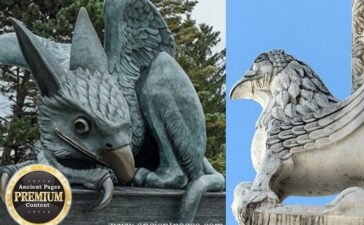2,000-Year-Old Roman Sandal With Nails Found In Germany

Jan Bartek – AncientPages.com – The Bavarian State Office for Monument Preservation’s archaeologists have uncovered evidence of a civilian settlement surrounding an auxiliary Roman fort dating from approximately 60 to 130 AD. The Roman camp is in Oberstimm, located about 50 miles north of Munich Among the artifacts discovered was a particularly intriguing item: the remnants of a well-preserved sandal sole with intact nails.
Reconstruction of the original appearance of the Roman sandal. Credit: Bayerisches Landesamt für Denkmalpflege
General Conservator Mathias Pfeil of the Bavarian State Office for the Conservation of Monuments (BLfD) emphasizes that exceptional discoveries such as the Oberstimm sole consistently demonstrate the ongoing acquisition of valuable information, even after completing archaeological excavations. This underscores the critical importance of the restoration team’s work.
Post-excavation, the artifacts, including characteristic Roman ceramics such as Terra Sigillata, food remnants, tools, and clothing components, underwent examination and preservation at the Bavarian State Office for the Conservation of Monuments to mitigate further deterioration.
Amira Adaileh, a specialist at the Bavarian State Office for the Conservation of Monuments, notes that the so-called Caligae were predominantly worn by Roman soldiers during the Roman Empire. This discovery indicates that the local population adopted Roman practices, lifestyles, and attires that were introduced to Bavaria.
X-ray analysis confirmed that it is the sole of a Roman sandal studded with nails. Credit: Bayerisches Landesamt für Denkmalpflege
During the early first century AD, the military personnel bestowed upon the young Gaius, aged approximately two to three years, the sobriquet “Caligula,” which translates to “little boot.” This appellation was derived from the child’s attire, which consisted of a miniature soldier’s uniform, complete with diminutive caligae.
The caligae, being open-toed footwear, would have provided superior ventilation compared to enclosed boots during marches. In the warm Mediterranean climate, this characteristic may have been advantageous. However, in northern Britain’s colder, damper conditions, additional insulation in the form of woven socks or raw wool padding may have been necessary during winter to maintain warmth.
Despite these adaptations, historical evidence suggests that caligae were phased out in northern Britain by the conclusion of the second century AD. In their stead, footwear more akin to civilian styles, specifically “closed boots” known as carbatinae, gained prevalence.
This is how the remains of the sole of the Roman sandal were found. Credit: Bayerisches Landesamt für Denkmalpflege
Furthermore, archaeological and historical records indicate that by the late fourth century AD, this transition from caligae to enclosed footwear had become widespread throughout the Roman Empire.
See also: More Archaeology News
While individual shoe nails are frequently encountered at Roman sites, their preservation with leather sole remains occurs only under specific conditions. The Oberstimm sole, for instance, was retrieved from a well. Comparable findings in Bavaria are currently limited to a few sites, providing valuable insights into Roman daily life and craftsmanship.
Written by Jan Bartek – AncientPages.com Staff Writer











